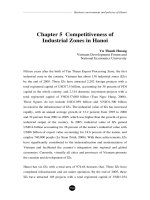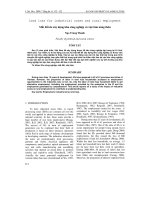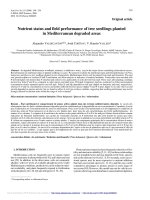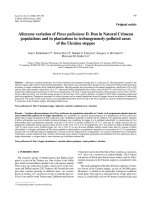Conducted in densely populated areas, industrial zones and ethnic minority areas
Bạn đang xem bản rút gọn của tài liệu. Xem và tải ngay bản đầy đủ của tài liệu tại đây (1.91 MB, 104 trang )
MINISTRY OF EDUCATION
AND TRAINING
SURVEY REPORT
Actual Situation and Management Mechanism
of Independent, Private Child Care Groups in Viet Nam
(Conducted in densely populated areas,
industrial zones and ethnic minority areas)
Ha Noi, October 2016
VIET NAM NATIONAL INSTITUTE OF EDUCATIONAL SCIENCES
RESEARCH CENTER FOR EARLY CHILDHOOD EDUCATION
SURVEY REPORT
ACTUAL SITUATION AND MANAGEMENT MECHANISM
OF INDEPENDENT, PRIVATE CHILD CARE GROUPS IN VIET NAM
(Conducted in densely populated areas,
industrial zones and ethnic minority areas)
Ha Noi, October 2016
INTRODUCTION
This study is conducted by the Research Center for Early Childhood Education, Viet
Nam National Institute of Educational Sciences, with technical and financial support from
UNICEF Viet Nam within the framework of the Education for Children Project for 20122016 between the Ministry of Education and Training and UNICEF Viet Nam.
About the Research Centre
Early Childhood Education Research Centre, Viet Nam National Institute of
Educational Sciences
During its 30 years of development, the Early Childhood Education Research Centre (hereafter
referred to as “the Center”) has made significant contributions to the development of early
childhood education and the improvement of early childhood education quality, meeting the
requirements of national socio-economic development through several research projects (at
ministerial and institutional levels) and by implementing projects and tasks at state, ministerial, and
institutional levels.
From its foundation to 1995, the Center carried out five state-level projects, tasks and themes,
six ministerial-level themes, and 25 institutional-level themes.
From 1995 to 2000, the Center carried out two ministerial-level projects and nine themes.
From 2000 to 2012, the Center carried out seven state-level projects and one theme, 20
ministerial-level themes and 24 institutional-level themes.
Since 2012, the Center has carried out three ministerial-level themes and tasks and four
institutional-level tasks, participated in various studies with the support of the UNICEF, PLAN and
WB, and participated in the development of guidelines and capacity-strengthening courses for local
early childhood teachers and administrators.
The Center's studies have contributed to:
- Providing scientific rationale for the development of a new early childhood curriculum
in line with the requirements of renovation and integration. The renovation of methods and
forms of educational activities, renovation of educational environments, implementation of
child activities, promotion of individual and group activities, all of which have been applied
in early childhood education, represent a significant step forwards in the renovation of early
childhood education methodology, contributing to improving the quality of early childhood
care and education in the first years of the 21st century.
1
- The studies on strategies, policies/models, and measures for the promotion of rural early
childhood education and non-public early childhood education have met the needs for early
childhood education development. The proposed solutions to transform semi-public early
childhood education institutions to other types (i.e. public, people-funded, and private) pursuant to
the 2005 Education Law, have contributed to providing the basis for the transformation of school
types suitable to local conditions.
The findings on the actual situation in the field, and the mechanism for private nursery
management with the goal of a mainstream and low-cost model for under-36-month-old
children in densely-populated, industrial, and ethnic minority areas in this report once again
affirm the Center's central role in providing scientific rationale for the steering of Viet Nam
early childhood education development in the coming period.
About the research team and participating experts
Head of the research team: Assoc. Prof. Nguyen Thi My Trinh, Ph.D., Director of the
Research Centre for Early Childhood Education
Research team: Members of the Research Centre for Early Childhood Education
Participating experts:
1- Tran Thi To Oanh, Ph.D, former VNIES official
2- Luong Thi Binh, M.A, former VNIES official
3- Nguyen Thi Quyen, M.A, former VNIES official
4- Nguyen Thi Hong Thuan, Ph.D, VNIES official
5- Hoang Thi Thu Huong, M.A, former VNIES official
6- Vu Yen Khanh, M.A, former VNIES official
7- Mai Thi Mai, M.A, VNIES official
2
TABLE OF CONTENTS
Acknowledgements .............................................................................................. 4
Glossary ................................................................................................................ 5
Abbreviations ....................................................................................................... 9
Summary of the study ....................................................................................... 10
PART A. General overview .............................................................................. 14
PART B. Research findings .............................................................................. 21
I. Vietnam’s policies and laws related to private early childhood education
institutions ........................................................................................................... 21
II. Demand for under-36-month-old child care and education, and preschool
capacity ................................................................................................................ 29
III. Actual situation of child care and education in private child care
groups/centres...................................................................................................... 37
IV. Private child care group/centre management managers ............................... 50
V. Management mechanism for private child care groups/centres ..................... 67
PART C. Impediments and measures to address impediments to the
management of private cchild care groups/centres towards a
mainstreaming and low-cost model ................................................................. 85
I. Impediments to the management of private child care groups/centres in
Vietnam ............................................................................................................... 85
II. Measures to address impediments to the management of private child care
groups/centres towards a mainstreaming and low-cost model ........................... 91
PART D. Conclusion and recommendations .................................................. 94
3
ACKNOWLEDGEMENTS
We wish to express our sincere thanks to local governments and Departments of
Education and Training in Ha Noi, Lao Cai, Vinh Phuc, Nghe An, Gia Lai, and Binh Duong,
including district People's Committees, Divisions of Education and Training, agencies and
organizations of participating districts, preschool administrators and teachers, heads of
neighborhoods, parents, hamlet and commune governments, and others, for their enthusiastic
sharing of information and opinions on private child care groups/centres and their
management in 12 wards and communes in the aforementioned provinces.
We also want to express our gratitude to the officers of the Education Programme
under the United Nations Children’s Fund (UNICEF) Viet Nam, who have provided us with
both technical and financial support to carry out the study. In particular, we highly appreciate
the close guidance of Ms. Joyce Patricia Bheeka, Chief of the Education Programme, and Ms.
Le Anh Lan, Inclusive Education Officer of UNICEF, throughout the surveying, data
processing, and report drafting. We are also grateful for the support of the VNIES leadership
and Department of Early childhood Education, Department of Planning and Finance,
Ministry of Education and Training during the study.
Finally, we want to extend our sincere appreciation to all individuals and organizations
for their sharing of accurate and helpful information. We could not have completed this study
without their valuable help. We hope that the research results will make a meaningful
contribution to policy development and revision to ensure the best care and education for
young children in Viet Nam and help to establish sustainable foundations for their future.
Sincerely,
The Research Team
4
GLOSSARY
1. Private nursery
According to Article 2 of the Merged Document No.4/VBHN-BGDDT dated January
27, 2014 on the Organization and Operation of Private Early childhood education
institutions,1 a private nursery is an early childhood institution under the national education
system of the Socialist Republic of Vietnam founded by social organizations, socioprofessional organizations, economic organizations or individuals with the permission of
competent state authorities. The funding for facilities and operation of private child care
groups/centres is from non-state budget sources. Private child care groups/centres carry out
child care and education for those between 3 and 36 months old in line with the early
childhood education curriculum issued by the Minister of Education and Training. In private
child care groups/centres, children are organized by age group with the maximum group size
as follows: 15 pupils for 3-to-12-month-old children, 20 pupils for 13-to-24-month-old
children and 25 pupils for 25-to-36-month-old children. If the number of children in each
group does not meet 50% of the maximum group size, they can be organized into mixed
groups.2 The number of children in a private nursery shall not exceed 50 pupils.3
2. Family group
Family groups are established spontaneously by families to meet the needs for child
care and education of family members, relatives or neighboring families. The caregivers and
educators are usually the elderly with child-raising experience, who have free time and love
children. The family groups usually make communal use of family facilities and food, or
sometimes receive voluntary contributions of cash or food from other members. Family
groups are not recognized as early childhood education institutions under the national
education system.
3. Education institution management
Education institution management is a set of goal-oriented attempts to influence an
institution to operate in line with educational principles to achieve its educational objectives.4
1
Attached to Decision No. 41/2008/QD-BGDDT dated July 25, 2008 of the Minister of Education and Training
Articles 13 and 22 - Preschool Charter and Articles 14 and 16 - Organization and Operation of Private
Preschools
3
Article 14 of the Organization and Operation of Private Preschools
4
Educational management science, Tran Kiem, Education Publisher 2008
2
5
Education institutions are thus under internal management (represented by the principal or
head of a nursery or kindergarten) as well as under upper-level and external management
(represented by sectoral management levels - Ministry, Department and Division - and local
government). For effective operation, education institutions need an appropriate management
mechanism.
4. Management mechanism
Mechanism (mécanisme), according to Le Petit Larousse (1999), is “the way a group
of interdependent elements operates.” Another definition of “mechanism” is a sequence of
steps to carry out a certain task. In other words, “mechanism is an arrangement in which a
process is carried out”.5
Management mechanism is an arrangement to carry out management and
administrative responsibilities. state management mechanisms are the collaboration and
coordination between relevant ministries and sectors, between ministries and sectors, the
Government and government agencies, as well as the people. The National Assembly drafts
laws, including legislation on the organization of the National Assembly and Government
agencies. The Government issues decrees on the structure, organization, and operation of
ministries and sectors. The Minister issues documents and regulations on the management of
the relevant ministry and subordinate agencies. Ministries and sectors issue joint circulars on
the collaborative mechanisms between those ministries and sectors.
The management mechanism of a given system is the management relationship in that
system based on the coordination between upper-level external management and the internal
management within the system to ensure effective fulfillment of management objectives.
Educational management mechanism includes a system of policies, principles,
regulations, and regimes regulating relationships at all levels between the subject and target
regarding educational activities.6 The management mechanism for education institutions is
best demonstrated in devolution and delegation between levels of administration.
5. Decentralization
Decentralization involves the transfer of power to lower levels to carry out actual
management duties and to reduce the workload of the upper level. Decentralization must
associate responsibility with power clearly and ensure uniformity from the central to
grassroots levels. Another viewpoint regards decentralization in two directions: horizontal,
based on differences within a level, and vertical, based on ranking between levels.
5
6
Vietnamese Dictionary published by the Institute of Linguistics in 2000.
Educational management science, Tran Kiem, Education Publisher 2008
6
Currently, on the basis of administrative and geographic division, Viet Nam has the
following government levels: central, provincial, district and commune. The decentralization
of state management should be understood firstly as the devolution between central and
provincial governments and then between local government levels.
The transfer of tasks and powers can only be carried out when the jurisdiction and
responsibility of the transferor and transferee have been determined (division of jurisdiction).
Division of jurisdiction is a prerequisite for the transfer of tasks and powers (or to be broader,
the adjustment of workload and power in line with the capacity and condition of each
government level).
The decentralization of state management consists of the division of jurisdiction and
responsibility between government levels based on the relations of workload and nature of
jurisdiction with the capacity and condition of each level to improve the quality, efficiency
and effectiveness of state management.
6. Delegation
Delegation is the granting of decision-making rights from upper-level administrators
to lower-level ones on matters within their power, but the upper level is still held responsible
for outcomes. Delegation can manifest in two forms:
- Official delegation: Through the chart of apparatus organization (e.g. each section
has clear roles and powers).
- Unofficial delegation: Through individual trust (e.g. the Director delegates to a
subordinate certain powers and responsibilities).
For delegation to be successful, it must be carried out responsibly by both sides: the
grantor and the grantee. The grantor must understand himself and his subordinate, make the
delegation appropriate to his roles and tasks, and review his work. The grantee must
recognize his responsibility to the superior when he is delegated powers, and know his
limitations so as not to overstep them. The grantor must set a clear command system but he
should not require blind obedience from the grantee, so that the grantee can have flexibility to
handle the work or even revise it if necessary. The grantor should also expect and tolerate
some mistakes made by the grantee.
Delegation needs to observe the following principles:
- Principle of inspection limit: Delegation should be within practical inspection limit.
Responsibility and power should not be granted to others if their work and decisions cannot
be inspected.
7
- Principle of sole power: Power must be transferred along with responsibility. Each
subordinate should be delegated one particular power.
- Principle of dual responsibility: The superior must always be held responsible for the
actions of his subordinates even when he has delegated to them.
Distinction between delegation, devolution and decentralization:
Devolution is the transfer of power to a lower level. Delegation for a long time will
become devolution.
Decentralization is the division of authority among administrators at all levels (high,
middle and low levels) so that each management level is assigned certain tasks and powers.
Regular control means low decentralization, low control means high decentralization.
7. Social organization
Social organization is a form of voluntary organization for specific objectives. It can
be the gathering of individuals with a certain background, employment, age, or sex. Diverse
in form and name, social organizations can be classified into socio-political organizations,
self-managed organizations, socio-professional organizations and mass organizations, such as
the Communist Party of Viet Nam, Ho Chi Minh Communist Youth Union, Viet Nam
General Confederation of Labour, Viet Nam Women’s Union, Economic Tribunal, Writers’
Union, Journalists’ Union, or Lawyers’ Union.
Social organizations organize and operate according to their Charter developed by
their own members or according to state regulations. The reciprocal relationship between
social organizations and state agencies is evidenced in the cooperation in legal enforcement:
mutual check from both directions.
8
ABBREVIATIONS
DOET
: Department of Education and Training
MOET
: Ministry of Education and Training
9
SUMMARY OF THE STUDY
In recent years, private child care groups/centres in Viet Nam have expanded in
number to meet the demand for under-36-month-old child care, as public early childhood
education institutions do not receive children at this age. How to manage the activities of
private child care groups/centres to ensure quality child care and education is not only an
issue for the sectoral administrators but also for researchers, all levels of government, and
social organizations, in order to meet people’s expectations, especially those with children in
this age range.
In 2015, the Early Childhood Education Research Centre, Viet Nam National Institute
of Educational Sciences, with the support of the UNICEF Viet Nam, carried out a study of
the actual situation and management mechanism of private child care groups/centres. Based
on this study, measures are recommended to address obstacles in management mechanism to
move towards a mainstreaming and low-cost model to contribute to improving the quality of
under-3-year-old child care and education in Viet Nam.
The study was carried out in densely-populated, industrial, and ethnic minority areas
in Viet Nam. Field surveys were limited to six provinces: Lao Cai, Ha Noi, Nghe An, Vinh
Phuc, Binh Duong and Gia Lai. The study focuses on 4 issues:
1. Private child care group/centre activities.
2. Private child care group/centre management managers
3. The current mechanism, participation, and collaboration with private child care
group/centre management by state management agencies, social organizations, and children’s
families.
4. Proposal of measures to address obstacles in management mechanism of private
child care groups/centres to move towards a mainstreaming and low-cost model.
Research methodology includes: secondary research involving reports and materials
of Early childhood Education Divisions under provincial DOETs and local Divisions of
Education and Training, in-depth interviews and group discussions, and observation of
educational activities, educational environment, child care, and education conditions.
10
KEY FINDINGS
- Legal documents related to state management of education and private child care
groups/centres show that the Party and state have encouraged and facilitated the
establishment of private early childhood education institutions by individuals and
organizations, including private child care groups/centres.
- The system of public early childhood education currently cannot meet the demand for
under-36-month-old child care, therefore the appearance of private child care groups/centres is
inevitable and essential. However, their child care and education quality is very limited. These
child care groups/centres focus on child care more than education, but the quality and safety of
these institutions are difficult to control. Child education activities in private child care
groups/centres have not been carried out in line with the early childhood education curriculum as
they lack facilities, funding, and personnel. Furthermore, regimes and policies to attract and
maintain teachers and child care group/centre staff are inadequate. As private child care
groups/centres try to remain inexpensive to suit people’s finances, low budgets are an obstacle to
the quality of child care, education, and sustainable development.
-
The MOET and provincial/municipal DOETs have issued various directives to
localities to improve the management of non-public early childhood education with particular
attention to the licensing of local private child care groups/centres. However, most
provincial/municipal governments usually assign the whole responsibility of private child
care group/centre monitoring and management to the education sector. The sector thus meets
many difficulties in the effort to collaborate with local governments and social organizations.
The establishment of private child care groups/centres has received the support and
guidance of governments at all levels, especially of district Divisions of Education and
Training and ward/commune People’s Committees, but the management of such institutions
after licensing is not really effective due to the lack of collaboration, decentralization, and
delegation between relevant parties. As a matter of fact, the decentralization of tasks is not
synchronized with the decentralization of jurisdiction and responsibility of financial and
personnel management, hence creating unnecessary confusion.
- Decentralization is not in accordance with the situation of local management and
sometimes even exceeds the capacity of local government. The decentralization of tasks takes
place too quickly while at lower levels it lacks capacity, in particular there is a lack of
quantity and quality of officials, leadership and administrators. In addition, the
decentralization has also not taken into account local socio-economic conditions. It is not
11
coordinated with plans for quality improvement, enhancement of upper level monitoring and
inspection, and assignment of responsibility. In addition, self-reporting and selfaccountability have not been fully achieved, while there is a lack of mechanisms to enforce
upper level management.
12
OBSTACLES IN THE PRIVATE CHILD CARE GROUP/CENTRE
MANAGEMENT MECHANISM
The study has identified obstacles in policies, regulations, and legal regimes in
private child care group/centre management at both central and local levels. Many documents
have not specified roles and tasks of relevant parties involved in child care group/centre
management, while some are too general and thus cause difficulties in implementation.
Moreover, policies to ensure fairness for children in non-public early childhood education or
those under three years old are lacking.
The implementation of existing policies and regulations also faces various
difficulties such as a lack of human resources and funding, a lack of awareness among
teachers and other staff, administrators, and people, a lack of collaboration and coordination
between relevant parties, as well as restrictions which make policies unfeasible in practice.
MEASURES TO ADDRESS OBSTACLES IN PRIVATE CHILD CARE
GROUP/CENTRE MANAGEMENT MECHANISMS TO MOVE TOWARDS A
MAINSTREAMING AND LOW-COST MODEL IN VIETNAM
Based on the findings of the study, we have proposed specific solution groups to reduce and
eliminate obstacles in private child care group/centre management mechanisms to move
towards a mainstreaming and low-cost model, namely solution groups on administrative
organization and policy, solution groups on economic-technical aspects, and solution groups
on the societal-individual level.
RECOMMENDATIONS
From the research results, we have made specific recommendations to the administration
from central to local levels in the review and revision of policies and laws, means of
implementation, collaboration, and mobilization in all levels of organizations, communities,
and individuals in private child care group/centre management to improve child care and
education quality.
13
PART A. GENERAL OVERVIEW
1. Research objectives and methodology
1.1. Research objectives
The research objectives are to review the management mechanism of different types
of private child care groups/centres in Vietnam, to serve as the basis for proposing measures
to address challenges in management mechanism, and to move towards a mainstreaming and
low-cost model of child care groups/centres, to improve the quality of infant care and
education in Viet Nam.
1.2. Research areas
-
Private child care group/centre activities
-
Private child care group/centre management managers
-
Current mechanism, participation, and collaboration for private child care
group/centre management by state management agencies, social organizations and
children’s families
-
Proposal of measures to address obstacles in management mechanism of private child
care groups/centres to move towards a mainstreaming and low-cost model
1.3. Research methodology
-
Secondary research and data analysis involved reports and materials of Early
childhood Education Divisions under provincial DOETs and local Divisions of
Education and Training on early childhood education and private child care
group/centre development over the last 3 years.
-
In-depth interviews and group discussion with relevant participants.
-
Observation of educational activities, educational environment, child care and
education conditions to make an objective and comprehensive assessment of child
care and education, private child care group/centre management and child care
group/centre management mechanism in Viet Nam, which would serve as the basis
for recommending measures to address obstacles in existing private child care
group/centre management mechanisms.
14
1.4. Research scope, duration and target
The field survey was carried out in 6 provinces: Lao Cai, Ha Noi, Nghe An, Vinh
Phuc, Binh Duong, and Gia Lai, and represented for three types of areas: highly populated
neighborhoods in the Red River Delta and North Central Coast; industrial zones in northern
and southern Viet Nam; and ethnic minority areas in the northwestern and southwestern
mountains.
15
Table 1.1. Areas selected to survey in Viet Nam
Type of Area
Province
District
Ward/Commune
Linh Nam ward
Ha Noi
Hoang Mai
Highly populated neighborhood
Thanh Tri ward
Quan Bau ward
Nghe An
Vinh
Le Loi ward
My Phuoc ward
Binh Duong
Ben Cat
Industrial zone
Thoi Hoa ward
Trung Nhi ward
Vinh Phuc
Phuc Yen
Hung Vuong ward
Coc Leu ward
Lao Cai
Lao Cai
Ethnic minority area
Ta Phoi commune
Alba commune
Gia Lai
Chu Se
Iahlop commune
Research period:
-
Developing research framework and survey tools: Quarter I, 2015
-
Conducting secondary research and field surveys: Quarter II, 2015
-
Processing data and drafting a secondary report on survey results: Quarter III, 2015
-
Drafting the general report and inviting experts for comments and revision: Quarter
IV, 2015 to Quarter I, 2016
-
Organizing a workshop to announce the project’s results: Quarter II, 2016
16
Table 1.2. Private child care groups/centres selected for survey
No.
Private child care group/centre
Type
Location
1
Cau Vong Child care group/centre
Licensed
Hoang Mai, Ha Noi
2
Baby Star
Licensed
Hoang Mai, Ha Noi
3
Tuoi Tho Cua Be
Unlicensed
Hoang Mai, Ha Noi
4
Sao Viet Child care group/centre
Unlicensed
Hoang Mai, Ha Noi
5
Anh Kim Child care group/centre
Licensed
Vinh, Nghe An
6
Hong Le
Licensed
Vinh, Nghe An
7
Hoa Hong Child care group/centre
Unlicensed
Vinh, Nghe An
8
Co Ngoc Child care group/centre
Unlicensed
Vinh, Nghe An
9
Sang Mai Child care group/centre
Unlicensed
Ben Cat, Binh Duong
10
Hoang Gia Child care group/centre
Unlicensed
Ben Cat, Binh Duong
11
Tuoi Tho Child care group/centre
Licensed
Phuc Yen, Vinh Phuc
12
Phuong Lien Child care group/centre
Licensed
Phuc Yen, Vinh Phuc
13
Vanh Khuyen Child care group/centre
Licensed
Coc Leu, Lao Cai
14
Thu Hang Child care group/centre
Unlicensed
Pho Moi, Lao Cai
15
Hoa Ngoc Lan Child care group/centre
Licensed
Alba, Chu Se, Gia Lai
16
Tuoi Tho Child care group/centre
Licensed
Iahlop, Chu Se, Gia Lai
Survey participants in each locality:
- Administrators at provincial DOET, Early childhood Education Division under
provincial DOET, district Division of Education and Training
- Administrators at district and communal People’s Committees
- Representatives of district state management agencies (health sector, women’s
union, etc.)
17
- Representatives of commune social organizations: neighborhood, women’s union,
youth union, etc.
- Principals of public early childhood education institutions assigned the task of
private child care group/centre management
- Managers and teachers of participating private child care groups/centres
- Parents with children enrolled or not enrolled in participating private child care
groups/centres
Table 1.3. Survey sampling
No.
Source of information
IDI GD Observation
1
DOET officials in charge of early childhood education
6
2
Officials of Division of Education and Training in charge of
6
early childhood education
3
Vice Chairman of provincial People’s Committee in charge
1
of education and information
4
Vice Chairmans of district People’s Committee in charge of
4
education and information
5
Vice Chairmans of ward/commune People’s Committee in
12
charge of education and information
6
Representatives of district Women’s Union and Health
6
6
sector
7
Representatives of district Ho Chi Minh Communist Youth
6
Union
8
Officials in charge of education, health, Women’s
Association,
Youth
Union
and
Party
Secretary
12
at
ward/commune level
9
Principals of public early childhood education institutions
18
12
No.
Source of information
10
Managers of private child care groups/centres and family
IDI GD Observation
6
6
groups
11
Early childhood education teachers in public early
5
childhood education institutions
12
Early childhood education teachers and babysitters in
5
6
private child care groups/centres
13
Young parents with children enrolled in private child care
12
6
groups/centres
14
Young parents with children not enrolled in anywhere
Total sample size
6
77
38
6
2. Code of Research Ethics
Research tools were developed and sent to early childhood education experts and local
officials for comments to ensure their suitability to the sources of information before being
implemented in the field survey.
The field survey was carried out with the permission of local governments regarding the
objectives, content, progress, and targeted groups of the project, so that localities could make
arrangements to facilitate the survey.
Before interviews and group discussions, members of the research team clearly stated the
objectives of the study, kinds of data to be collected, the way data would be used in the study,
and guaranteed participants’ confidentiality. During the field survey, photographs for
activities relevant to the study were taken with permission. Pictures are only used to illustrate
comments in the study.
The data collected are all without personal information such as name, location,
workplace, to ensure confidentiality and safety of informants.
19
3. Research limitations
Due to limited time and resources, the selection of six provinces to represent three areas
for the field survey cannot reflect a 100% complete and comprehensive picture of the
situation in Viet Nam.
Despite having informed them of our intentions and asked for permission, the research
team was only able to meet one out of six provincial People’s Committee officials, and four
out of six district People’s Committee officials. Therefore, the information relevant to private
child care group/centre management mechanisms at provincial and district levels was mostly
collected through secondary sources.
The survey was conducted in a short time period (5 days per province). Since private
child care group/centre management mechanism is a complex issue involving different
management levels, time limitations may be a factor in the quality of the field work.
In addition, the research methods are mostly qualitative, which cannot ensure the
objectivity of quantitative data which is usually used in studies on educational sciences and
early childhood education.
20
PART B. RESEARCH FINDINGS
I. VIET NAM’S POLICIES AND LAWS RELATED TO PRIVATE
CHILD CARE GROUPS/CENTRES
Based on the study of legal documents related to state management of education and
private child care group/centre management (see Appendix), we find that guidelines and
policies of the Party and state have encouraged and created favorable conditions for
individuals and organizations to found private and people-founded early childhood education,
including private child care groups/centres. However, the network of non-public early
childhood education, including private child care groups/centres, in each locality, should be
planned according to local conditions. In addition, more concrete guidelines should be issued
to encourage the development of private early childhood education institutions and private
child care groups/centres in areas with high demand for child care.
1. Supportive policies for non-public early childhood education insitutions including
private child care groups/centres
Policies encouraging the socialization of education of the Party and state are stipulated in
several legal documents (Constitution 2013) Party documents from the sixth to twelfth
Congresses, Education Law 2005 [amended in 2009], Government’s Resolution No.
05/20015/NQ-CP on the Organization and Operation of Private Early childhood education
institutions), which serve as the legal basis for education development and facilitate the
establishment and development of non-public early childhood education including private
child care groups/centres. Following are some examples:
- Preferential treatment for non-public education institutions:
The Vietnamese Party and government have issued policies to encourage non-public
education institutions.
For learners: Article 68 of the 2005 Education Law stipulates that people-founded and
private schools are guaranteed funding by the state to provide policies for learners.
However, to ensure equal treatment between crèche and child care group/centre admission,
between disadvantaged children, poor children and handicapped children, etc. in non-public
early childhood education institutions, more specific and practical policies are needed.
For non-public early childhood education institutions: Government Decree No.
53/2006/ND-CP provides supportive policies regarding facilities and land use: Non-public
21
early childhood education institutions can obtain long-term, low-rent facilities and housing,
or be assigned land to build facilities under various forms: (1) Land assignment with no landuse tax; (2) Land assignment with land-use tax exemption; (3) Land rental with no rent. In
addition, there are policies to reduce and exempt taxes, fees and charges for non-public
schools and investors to encourage investment in education development. The state also
offers preferential credits for development investment. Regarding school fees and charges,
the state lets non-public early childhood education institutions set their own. Two documents
are of particular interest, namely Decree No. 59/2014/ND-CP (amending and supplementing
a number of articles in Decree No. 69/2008/ND-CP) on policies to encourage socialization
of activities in the sector of education, vocational training, health, sports and environment,
and Circular No. 156/2014/TT-BTC guiding the implementation of regulations on equal
respect and treatment towards socialized institutions’ products and services. Socialized
institutions in education, vocational training, health, culture, sports and environment are free
from pre-registration fees when they register for land-use rights and ownership of landattached property as well as from other fees and charges related to the use of land and landattached property. Decree No. 218/2013/ND-CP specifying the implementation of the Law
amending and supplementing a number of articles in the Law on Business Income Tax
stipulates that enterprises investing in socialization of education and training, vocational
training, health, culture, sports and environment shall pay reduced tax on income from the
socialized activities.
These policies have contributed greatly to the socialization of education and facilitating
the foundation and development of non-public education institutions including private child
care groups/centres.
- For non-public early childhood education institutions in different regions and
areas, especially in export processing and industrial zones:
In urban areas: The resolution of the 8th Plenum of the 11th Central Committee points out
that encouraging the development of non-public school types meets the social demand for high
quality education in urban areas. However, at present there are no specific guidelines on the
development of high quality early childhood education institutions in these places.
In export processing and industrial zones: On March 20, 2014, the Prime Minister issued
Decision No. 404/QD-TTg approving the Project “Supporting the development of private child
care groups/centres in exporting processing and industrial zones by 2020”. This is a
22









